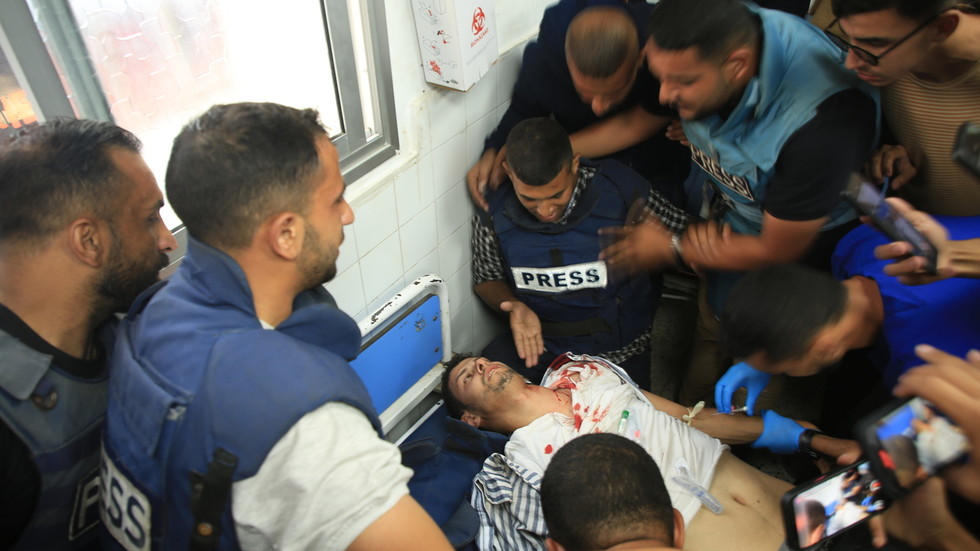Over 160 media workers have lost their lives and 60 have been detained amidst the ongoing devastation in northern Gaza, where the humanitarian situation is dire, and the brutal military campaign by Israel continues unabated. The Israeli government has escalated its siege on northern Gaza, preventing essential humanitarian aid from reaching an already desperate population of 400,000 Palestinians who face starvation. The recent parliamentary decision to prohibit the United Nations Relief and Works Agency (UNRWA) from operating further complicates the already critical situation. As reports indicate, Israeli forces have systematically targeted essential infrastructure, including water stations and communication networks, resulting in an even graver situation where many are isolated from the outside world. Reports from organizations like Euro-Med Monitor highlight that in just two weeks, 500 Palestinians have been confirmed dead, with many more unaccounted for amidst the chaos and destruction.
The assault on healthcare facilities in northern Gaza signifies another alarming casualty of the ongoing violence. Reports indicate a coordinated attack on the Indonesian Hospital in Beit Lahia, where the Israeli army not only surrounded the hospital but also bombarded it and cut off its electricity supply. This pattern of targeting medical personnel and facilities has been a grim hallmark of the conflict, reminiscent of previous assaults. The inviolability of medical care under international law seems to hold little significance for Israeli forces, who continue to attack rescuers on the ground, further ensuring that the wounded are left without critical medical assistance. The unprovoked targeting of a child captured in a harrowing video shows a disturbing trend of violence designed to terrorize the local population, where the lethargy of the international community has become glaringly visible in the face of such atrocities.
The methods employed by the Israeli army to inflict harm have reached new technological extremes, with reports emerging of robots equipped with explosives being utilized in civilian areas. This development, coupled with the deployment of quadcopters and the setting of explosive traps in residential neighborhoods, conveys a grim picture of total disregard for human life. Eyewitness accounts depict a horrifying environment where choosing to seek food results in life-threatening consequences, as residents risk encounters with Israeli soldiers or aerial surveillance. The forced displacement of civilians is seen as a continuation of the long history of land appropriation and violence in Gaza, aggravating the plight of people who have already faced forced removal since the Nakba of 1948.
The ongoing war on journalists further compounds the challenges facing coverage of the situation. The high-profile injury of Palestinian journalist Fadi al-Wahidi, who was shot while covering actions in Jabalia, underscores the dangerous environment that media professionals operate within. The dire consequences of their work, including casualties and the indifference of both local and international press organizations, leave many media workers vulnerable. While the Committee to Protect Journalists confirmed al-Wahidi’s injury, the lack of acknowledgment from other watchdogs highlights a troubling pattern where the plight of Palestinian journalists is often overlooked, further complicating the narrative around the violence in Gaza.
Daily updates reveal the gruesome reality on the ground, as Palestinian journalists like Hossam Shabat capture the relentless bombardment targeting displaced civilians and essential infrastructure. The horrors described, including the indiscriminate shelling around hospitals, illustrate the chilling state of affairs in Jabalia, where civilians are systematically targeted while attempting to seek refuge. The descriptions of bodies scattered along roads and the forced displacement of thousands underline the ramifications of the Israeli offensive in northern Gaza. U.S. Secretary of State Antony Blinken’s recent statements regarding the humanitarian situation in Gaza, calling for improvements within 30 days, echo a long-standing pattern of empty promises that affords Israel the leeway to further its military agenda with impunity.
Despite international condemnation and the apparent horror unfolding in Gaza, the steadfast support of the U.S. government for Israeli military actions suggests little likelihood of a change in course. The arguments made by officials seem to lack any genuine intent to protect civilian lives, portraying a bleak picture of complicity in the ongoing ethnic cleansing efforts being documented in real-time. As Israel pursues its long-term vision of territorial control, as seen in the alarming aspirations of former Prime Minister Ariel Sharon, concerns arise that the atrocities observed in northern Gaza may extend across the entirety of the Strip. Thus, the portrayal of the situation in Gaza as an unfolding genocide raises urgent questions about humanity’s moral stance and the necessity for substantive intervention to address and halt the ongoing violence targeted at innocent civilians.

